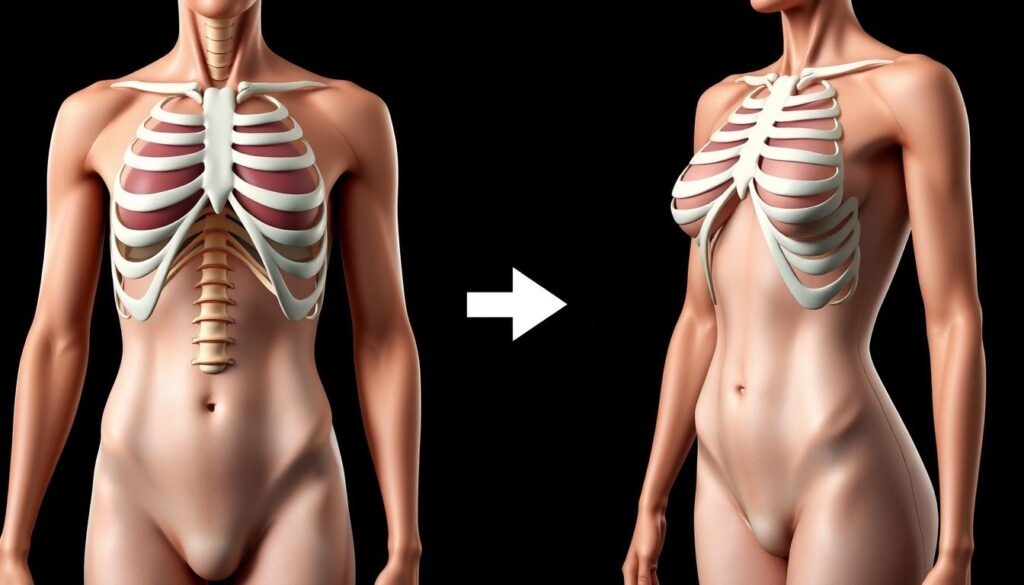Rib removal surgery, also known as rib resection, has gained popularity in recent years, especially among individuals seeking a more defined waistline. While the procedure can offer aesthetic benefits, it’s essential to understand the associated risks and considerations before making an informed decision.
Understanding Rib Removal Surgery
Rib removal surgery involves the surgical excision of one or more ribs, typically the 11th and 12th pairs, to achieve a narrower waist. This procedure is often sought for cosmetic reasons but can also be performed for medical indications.

Potential Risks and Complications
Like any surgical procedure, rib removal carries inherent risks. Being aware of these potential complications is crucial for anyone considering the surgery:
1. Infection
Post-operative infections can occur, necessitating antibiotics or additional surgical intervention.
2. Bleeding
Excessive bleeding during or after surgery may require blood transfusions or further medical procedures.
3. Scarring
Incisions made during the procedure can lead to visible scars, which may be a cosmetic concern for some patients.
4. Pain
Chronic pain or discomfort in the surgical area can persist, sometimes requiring long-term pain management strategies.
5. Damage to Internal Organs
There’s a risk of injury to nearby organs, such as the lungs, which can lead to complications like pneumothorax (collapsed lung).
6. Respiratory Issues
Removing ribs can potentially impact respiratory function, leading to shortness of breath or reduced lung capacity.
7. Nerve Damage
Surgical manipulation may result in nerve injury, causing numbness, tingling, or loss of sensation in certain areas.
8. Anesthesia Risks
General anesthesia carries its own set of risks, including allergic reactions and complications related to underlying health conditions.
Recovery and Aftercare
Recovery from rib removal surgery varies among individuals but generally includes:
Hospital Stay: Patients may need to stay in the hospital for monitoring immediately after surgery.
Pain Management: Medications are prescribed to manage post-operative pain.
Physical Activity: Limited movement is recommended initially, gradually increasing as healing progresses.
Follow-Up Appointments: Regular check-ups are necessary to monitor healing and address any complications.
Why Choose Cayra Clinic for Rib Removal Surgery?
At Cayra Clinic, we are proud to be one of Turkey’s most trusted names in aesthetic and cosmetic surgery. If you’re considering rib removal surgery for a more contoured waistline, our clinic offers expert care, world-class technology, and personalized treatment in a safe and welcoming environment.
Our team of internationally trained surgeons has extensive experience in body contouring procedures, including liposuction, tummy tuck, and rib resection surgery. We focus on safety, precision, and natural-looking results tailored to your individual goals.
Why Patients Choose Cayra Clinic:
Comprehensive Patient Care: From the first consultation to post-operative support, we offer a seamless experience.
Advanced Techniques: We use minimally invasive methods when possible to reduce scarring and recovery time.
Affordability Without Compromise: World-class treatments at competitive prices in Turkey.
Medical Travel Support: Our team helps with airport transfers, accommodation in top-rated partner hotels, and translation services.
You can also learn more about our mission and expertise by visiting our About Us page.
Ready to start your transformation?
Contact us today to schedule your free consultation with our specialists. We’re here to answer your questions and guide you every step of the way.
Frequently Asked Questions
Is rib removal surgery safe?
Rib removal is generally safe when performed by an experienced surgeon, but like any surgery, it comes with potential risks such as infection, nerve damage, and scarring.
What are the most common risks of rib removal surgery?
The most common risks include infection, bleeding, poor wound healing, nerve injury, and asymmetry in the torso.
Can rib removal affect breathing?
In rare cases, removal of lower ribs may slightly affect chest wall stability, but it typically does not impair breathing when done correctly.
Is rib removal surgery painful?
Yes, patients often experience pain and discomfort during the recovery period. Pain is usually managed with medications.
Will rib removal leave scars?
Yes, scarring is expected, especially around the incision area. Surgeons usually place incisions in discreet locations to minimize visibility.
Can rib removal cause long-term side effects?
While most patients recover without major issues, some may experience persistent numbness, sensitivity, or rib instability.
What are the signs of complications after rib removal?
Signs include fever, excessive pain, pus from the incision site, or difficulty breathing. These should be reported to a doctor immediately.
How likely is nerve damage from rib removal?
Nerve damage is possible, especially to the intercostal nerves between the ribs. This may cause numbness or tingling around the area.
Is rib removal reversible if something goes wrong?
No, once a rib is removed, it cannot be replaced. This makes the procedure irreversible, which is why it’s critical to choose a qualified clinic.
How can I reduce the risks of rib removal surgery?
Choose a reputable, board-certified clinic, follow all pre-op and post-op instructions, and ensure the procedure is done in a medically safe environment like Cayra Clinic in Turkey.
